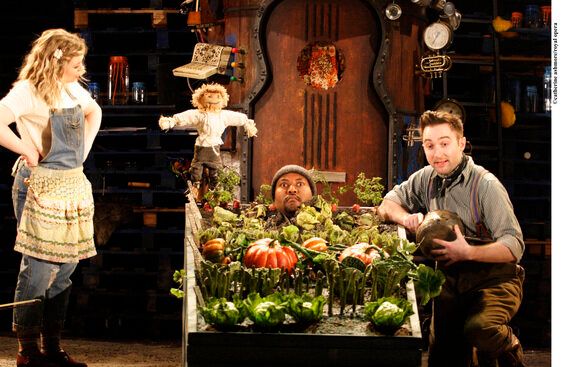
I applaud initiatives in opera to break new ground, to create new works that will entice new audiences but this adaption of the much-loved Ted Hughes stories is unlikely to win many converts to the art form.
How the Whale Became is a series of tales that focus on different animals with an eccentric and creative depiction of the many ways they came to be. The animals on display here are cleverly depicted, from the icy cool polar bear and the jet-spouting whale in his large glitter bath, to the frog in a trainee water-ring and the solitary elephant both struggling to come to terms with who they are.
Aimed at children from five years upwards, How the Whale Became is a story about self-acceptance, which is a great message for kids but the message is lost in a mixed production that never really catches fire.
The main attraction is Tony Scutt's brilliantly inventive set. Set in God's allotment, his garden of creation, stacks of blue painted pallets are packed high with plants and sprouting garden plots scattered amongst them. And proudly in the middle stands God's creation machine, cleverly comprised of instruments, into which the naked animals go for their sprinkling of magic dust to transform them into what they were always destined to be.
The cast is irrepressibly joyful and they worked hard to keep the audience engaged and the piece playful. Adapted by Julian Philips (music) and Edward Kemp (libretto), the story zipped along with its colourful array of characters - Frog, Elephant, Whale, Lion - and didn't let the central plot of the budding romance between Boy and Girl distract from this main draw.
So why doesn't this production work? In summary, the musical score.
The music is disappointing. Not only are all the tunes at a drab slow pace, the choice of percussion doesn't help. The accordion is jarring and its combination with a bizarre array of support such as rustling tree branches and taps on flower pots seemed more of a gimmick than a positive addition.
Attention to the acoustics also wasn't there. The libretto was almost completely inaudible, struggling to be heard over the drone of the accordion. And what I could hear sounded simplistic. "Boy loves girl;" "Boy wants to marry girl."
Yet having said that, the simplistic language combined with really sharp, inventive costume design (also by Tom Scutt) seemed enough to capture the attention of the younger members of the audience. Given the show is two hours long, the children in the audience were surprisingly not restless - unlike the adults.
So overall How the Whale Became is a mixed bag, a victory of impressive style over its disappointing substance.
Linbury Studio, Royal Opera House
To January 4, 2014